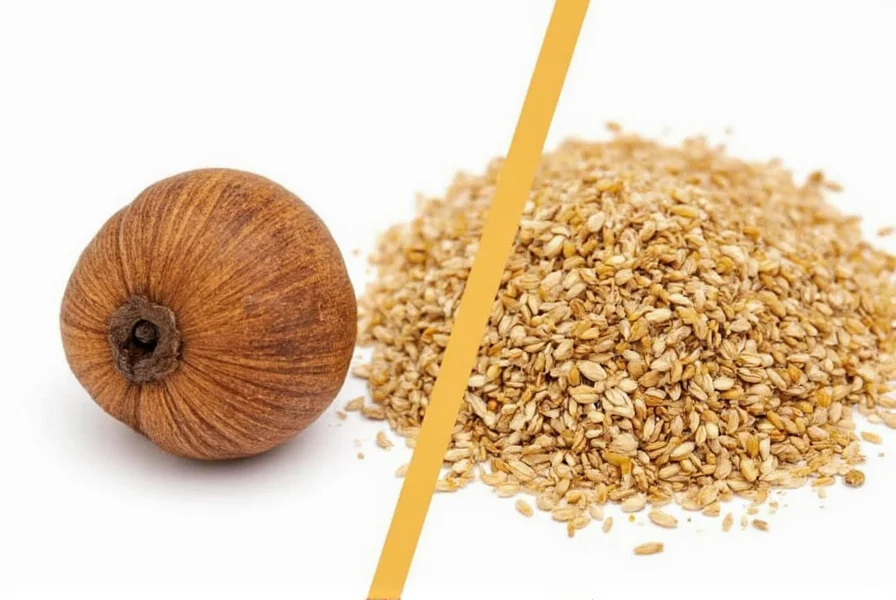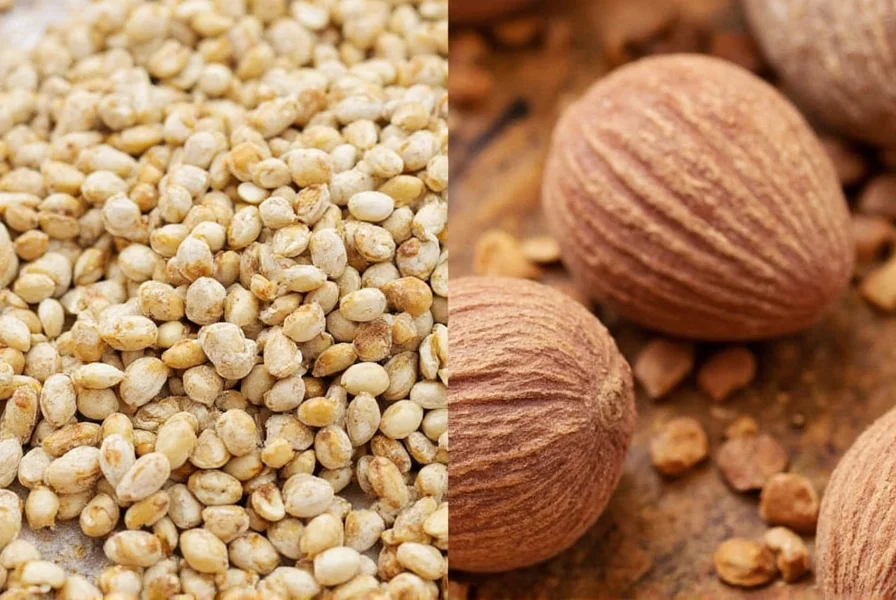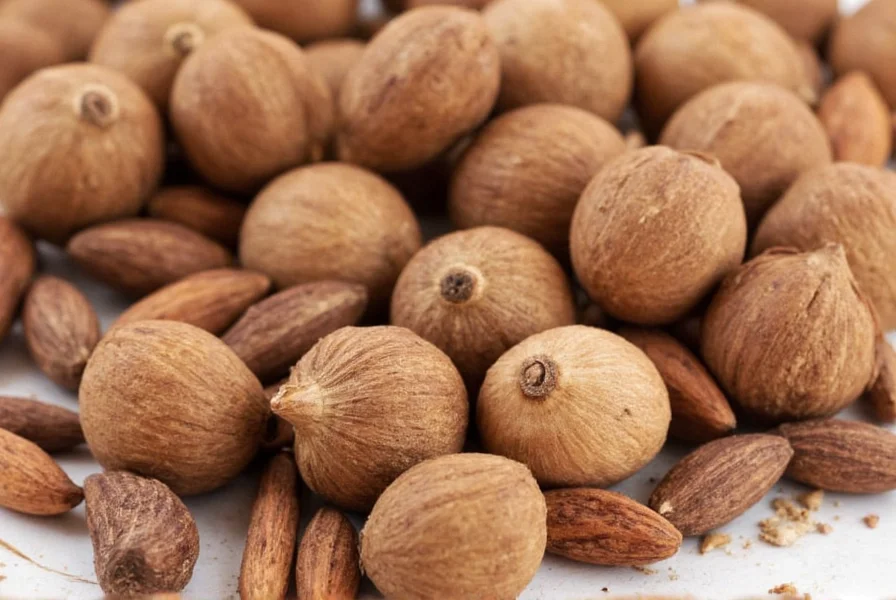Understanding the relationship between mace and nutmeg unlocks new dimensions in spice usage. These two spices, derived from the same evergreen tree native to the Banda Islands of Indonesia, represent one of nature's most fascinating botanical partnerships in the culinary world. While many home cooks treat them as interchangeable, their subtle yet significant differences can transform your cooking when used appropriately.
The Botanical Connection: One Fruit, Two Spices
When the fruit of the Myristica fragrans tree ripens, it splits open to reveal the nutmeg seed wrapped in its crimson aril—the source of mace. Harvesters carefully separate these components, then dry them independently. The seed becomes nutmeg, while the aril dries into brittle, orange-red blades that constitute mace. This shared origin explains their similar aromatic compounds, yet their distinct chemical compositions create unique flavor experiences.
| Characteristic | Mace | Nutmeg |
|---|---|---|
| Source on Fruit | Red aril surrounding seed | Hard seed inside fruit |
| Flavor Profile | More delicate, citrusy, with subtle pepper notes | Warmer, sweeter, more intense woody notes |
| Color Impact | Imparts golden hue to dishes | Less color influence |
| Typical Culinary Use | Fish, light sauces, baked goods, delicate dishes | Hearty dishes, cheese sauces, winter beverages, robust recipes |
| Substitution Ratio | 1 part mace = 1.5 parts nutmeg | 1 part nutmeg = 2/3 part mace |
Flavor Profiles and Culinary Applications
Mace's more delicate flavor makes it ideal for dishes where you want spice presence without overwhelming other ingredients. Professional chefs often reach for mace when seasoning fish, light-colored sauces, and delicate baked goods where nutmeg might dominate. Its subtle citrus notes complement seafood exceptionally well, while its golden hue enhances visual appeal without discoloring dishes.
Nutmeg delivers a warmer, sweeter punch that stands up to heartier preparations. It's indispensable in classic béchamel sauces, adds depth to potato dishes, and creates that signature warmth in holiday eggnog. When grated fresh, nutmeg releases volatile oils that create a more complex flavor profile than its pre-ground counterpart.

Practical Usage Guidelines for Home Cooks
For optimal flavor, always choose whole spices over pre-ground versions. A microplane grater works perfectly for both, though mace requires slightly more pressure due to its brittle nature. Store your whole spices in airtight containers away from light and heat—properly stored, they'll maintain peak flavor for 2-3 years.
When substituting between these spices, remember that mace is generally more potent by volume despite its more delicate flavor profile. For recipes calling for nutmeg, use approximately two-thirds the amount of mace if substituting. Conversely, when replacing mace with nutmeg, increase the quantity by about 50%.
Certain regional cuisines showcase these spices particularly well. In Dutch cooking, mace features prominently in traditional pea soup, while nutmeg anchors the flavor profile of New England clam chowder. Indian cuisine often uses nutmeg in garam masala blends, whereas mace appears in delicate biryanis where its subtle warmth enhances without overpowering.
Avoiding Common Spice Mistakes
Overuse represents the most frequent error with both spices. Their potent essential oils can quickly turn pleasant warmth into medicinal bitterness. Start with small amounts—1/8 teaspoon for mace or 1/4 teaspoon for nutmeg in a standard four-serving dish—and adjust during cooking.
Another common mistake involves improper storage. Exposure to air, light, and humidity rapidly degrades their volatile oils. Keep your whole nutmeg and mace in dark glass jars with tight-sealing lids, preferably in a cool, dark cabinet rather than near your stove where temperature fluctuations occur.

Historical Context and Modern Production
Historically, the Dutch went to extraordinary lengths to maintain their monopoly on nutmeg and mace production, even scorching islands to prevent unauthorized cultivation. Today, these spices grow in several tropical regions including Grenada (which features nutmeg on its national flag), India, and Malaysia.
Modern harvesting remains labor-intensive. Workers must pick the fruit at precisely the right ripeness, then carefully separate the mace from the nutmeg within 24 hours to prevent mold. This time-sensitive process contributes to mace typically commanding a higher price than nutmeg—often 20-30% more—due to the additional processing required.
Frequently Asked Questions
Can I substitute mace for nutmeg in baking recipes?
Yes, but with adjustments. Use approximately two-thirds the amount of mace when replacing nutmeg, as mace has a more concentrated flavor despite its delicate profile. In delicate cakes and pastries, mace often provides a more nuanced warmth without overwhelming other flavors.
Which spice lasts longer when stored properly?
Both spices maintain freshness for 2-3 years when stored in airtight containers away from light and heat. Whole forms significantly outlast pre-ground versions, which lose potency within 6-12 months. Mace may retain its flavor slightly longer than nutmeg due to its lower oil content, but proper storage matters more than the spice type.
Why does mace cost more than nutmeg?
Mace commands a higher price primarily due to processing requirements. Each nutmeg seed yields only a small amount of mace (the aril), and the delicate covering must be carefully separated and dried within 24 hours of harvest. This labor-intensive process, plus mace's more limited culinary applications, contributes to its typically 20-30% higher cost compared to nutmeg.
Does the flavor difference matter in savory dishes?
Absolutely. In light-colored sauces, soups, and fish dishes, mace provides subtle warmth without the stronger woody notes of nutmeg. For heartier meat dishes, stews, and cheese sauces, nutmeg's robust profile stands up better to bold flavors. Professional chefs often use both in layered spice blends where their complementary notes create more complex flavor dimensions.











 浙公网安备
33010002000092号
浙公网安备
33010002000092号 浙B2-20120091-4
浙B2-20120091-4